- Home
- Publications et statistiques
- Publications
- Monthly Business Survey – Start of Decem...
The Banque de France publishes a range of monthly and quarterly economic surveys that provide a snapshot of the French economy in the form of business climate indicators and short-term forecasts.
According to the business leaders surveyed (approximately 8,500 companies and establishments questioned between 27 November and 4 December), activity rose in November in market services and changed very little in industry and construction. In December, business leaders expect activity to continue to grow moderately in market services, while contracting slightly in industry and more sharply in construction. Overall, order books remained weak, and this was the case in all industrial sectors except aeronautics.
Our uncertainty indicator is based on comments from the companies in the three sectors. It reached its highest level for two years in industry and construction, with the responses highlighting in particular the uncertainty of the domestic political climate.
Selling prices continued to moderate, despite a slight rise in raw material prices, according to business leaders.
Recruitment difficulties remained almost unchanged, affecting 32% of companies across all sectors, after 31% in October.
On the basis of the survey results, supplemented by other indicators, we expect underlying growth to continue to trend slightly upwards in the fourth quarter. This would suggest GDP remaining stable compared with the previous quarter, taking into account the impact of the Olympic and Paralympic Games (estimated at 0.2 percentage point of GDP).
1. In November, activity changed little in industry
and construction, and grew moderately
in market services
In November, industrial activity was flat, at a level in line with business leaders’ expectations for the previous month, and slower than the already subdued growth seen in previous months. The agri‑food sector slowed after a fairly buoyant October, as did capital goods to a lesser extent; transport equipment was up sharply, while the other industrial sectors contracted. More specifically, the automotive sector bounced back after a very weak October, driven by sales of commercial vehicles and manufacturers catching up on production following the delayed launch of new models.
The wearing apparel‑textiles‑footwear, aeronautics and machinery and equipment sectors grew, while rubber and
plastic products, metal and metal products and other industrial products declined.
CAPACITY UTILISATION RATE
(%)
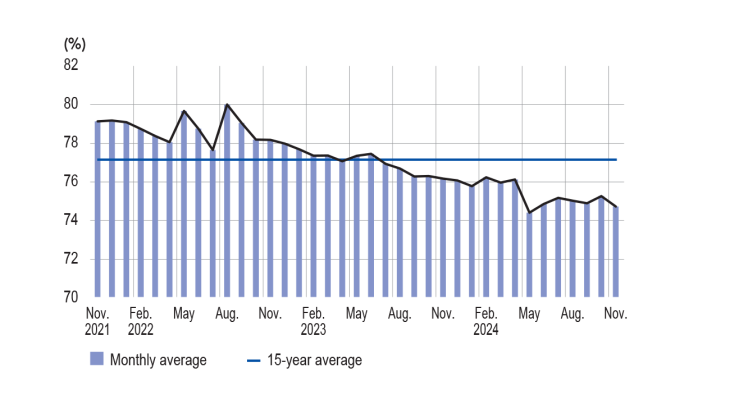
The capacity utilisation rate (CUR) for industry as a whole fell to 74.7% (after 75.2%). The indicator declined in most sub‑sectors, including rubber and plastic products (down 2 percentage points) and metal and metal products (down 1 percentage point). It remained stable in the wood‑paper‑printing, wearing apparel‑textiles‑footwear and aeronautics sectors.
BALANCE OF OPINION ON THE OUTLOOK FOR ACTIVITY
(balance of opinion, adjusted for seasonal and working‑day variations, for December: forecast)
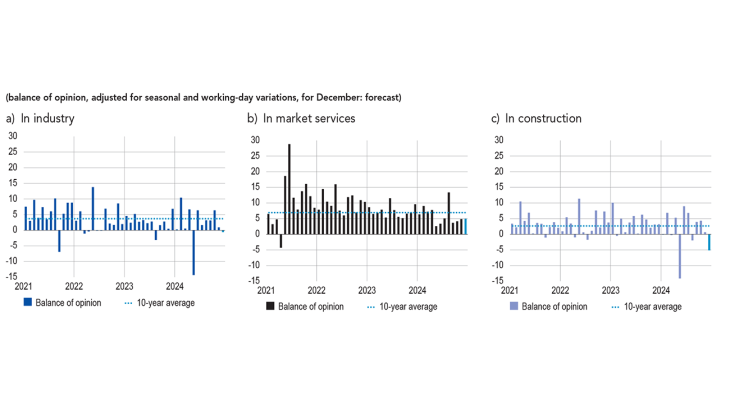
over the past month) stood at 1 percentage point for November in industry. For December (light blue bar), business leaders in industry expect activity to decline by 1 percentage point.
Inventories of finished goods were down slightly compared with October. They rose in chemicals, other industrial products and machinery and equipment, but fell in rubber and plastic products, pharmaceuticals and the automotive industry. Nevertheless, they remained at levels considered high and above their long‑term average in almost all sectors, particularly in the aeronautics (as an indirect consequence of supply chain difficulties) and chemicals sectors.
In market services, activity is growing slightly faster than in October and than expected by business leaders last month. However, growth remained subdued, below the long‑term average. Leisure activities and personal services slowed sharply after a strong October.
INVENTORIES OF FINISHED GOODS IN INDUSTRY
(balance of opinion, adjusted for seasonal and working day variations)
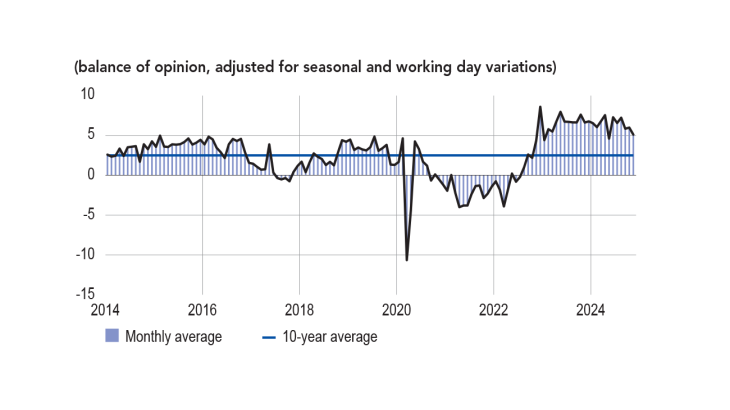
Temporary work (which is being hit by headwinds in the construction and automotive sectors) and advertising and market research (due to a wait‑and‑see attitude among clients) are down for the third and fourth consecutive month respectively.
The other sub‑sectors were up, particularly engineering, food services (thanks to good weather) and vehicle repairs.
In construction, after rebounding in October as a result of the postponement of building projects during the Olympic Games, activity in the structural works sector further declined. It rose very slightly in the finishing works sector.
The balance of opinion on cash positions remained unfavourable in industry. It worsened in particular in the
automotive, chemicals, rubber and plastic products and wearing apparel‑textiles‑footwear sectors, but recovered
slightly in the computer‑electronics‑optical products and aeronautics sectors. In some industries, such as chemicals and aeronautics, business leaders identified longer payment times as a factor affecting their cash position.
In market services, the balance of opinion on the cash position was once again positive, although it varied widely across sub‑sectors. The cash position was positive in publishing, engineering, leisure and personal services. In contrast, it was negative in information services and cleaning.
CASH POSITION
(balance of opinion, adjusted for seasonal and working day variations)
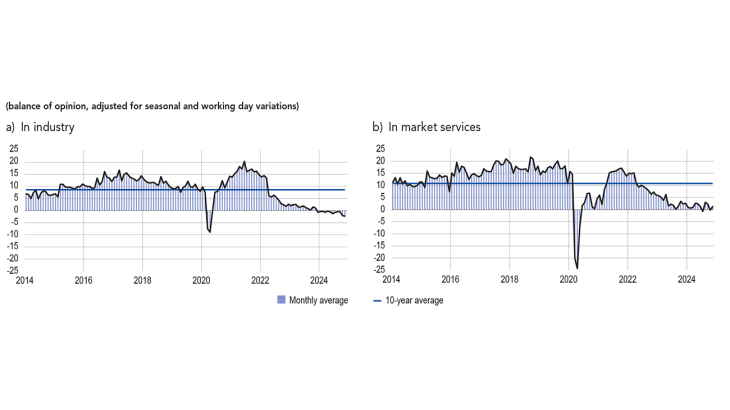
2. In December, according to business
leaders’ expectations, activity is set to fall slightly in industry and significantly in construction,
while it should continue to grow moderately in market services
In December, business leaders in industry expect activity to decline across the board, par ticularly in wearing
apparel‑textiles‑footwear, machinery and equipment, and metal and metal products. In contrast, continued growth is expected in the aeronautics, chemicals, pharmaceuticals and agri‑food sectors. The automotive sector is expected to slow down a little.
In market services, activity is expected to grow slightly overall, with varying trends across sub‑sectors. Motor vehicle rental is expected to rebound, while publishing, accommodation and food services, transport and warehousing and certain business services (notably engineering, legal and accounting activities) are expected to record further growth. Conversely, advertising and market research, as well as temporary work, are expected to continue to decline.
In the construction sector, activity is expected to wane in both structural and finishing works.
At the end of November, industrial order books were still considered weak in all sectors except aerospace. They were particularly weak for rubber and plastic products, machinery and equipment (a drop in orders from customers in the automotive sector), wood‑paper‑printing (a decline in orders from the construction industry), automotive products and wearing apparel‑textiles‑footwear. Order books were deemed to be well below their long‑term average in all sectors except aeronautics.
In construction, order books showed little change this month; they remained particularly depressed in the structural works sector, despite the upturn seen in previous months. Companies stressed the uncertainty surrounding the future of construction incentives (Pinel Law, zero‑rate loans).
Our monthly uncertainty indicator, which is constructed from a textual analysis of comments by surveyed companies, rose in all three sectors. In construction and industry, it reached its highest level for two years. In this respect, business leaders mainly highlighted uncertainty surrounding the domestic political climate (future economic and fiscal policies).
LEVEL OF ORDER BOOKS
(balance of opinion, adjusted for seasonal and working day variations)
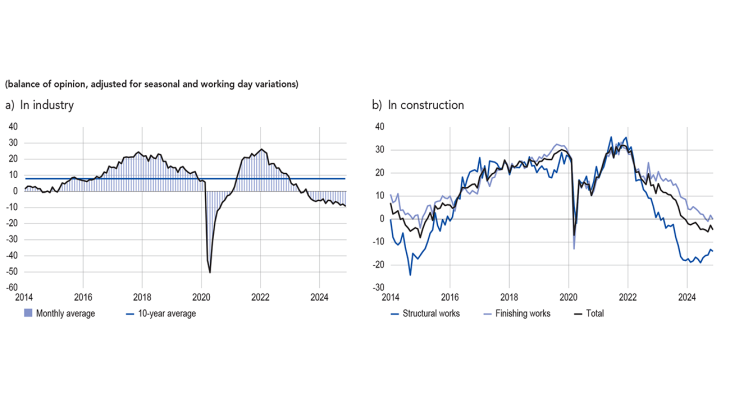
INDICATOR OF UNCERTAINTY IN THE COMMENTS SECTION OF THE MONTHLY BUSINESS SURVEY (MBS)(unadjusted data)
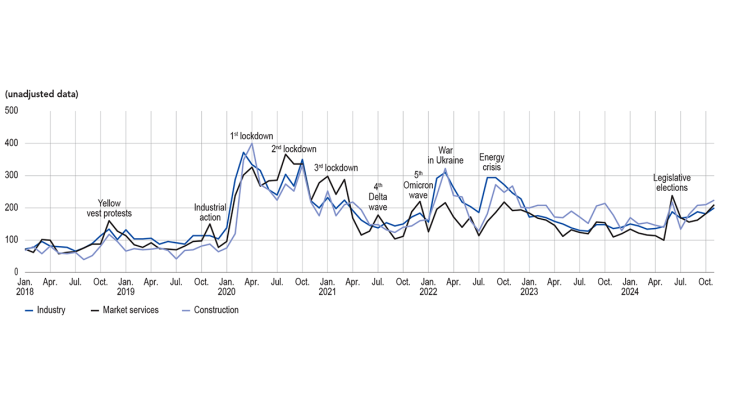
3. Selling prices continued to moderate
In November, supply difficulties eased slightly compared to the previous month (9% of companies reported them).
In the transport sector, which was the most affected, they fell in aeronautics (33%), but rose in the automotive sector (23%). Supply difficulties in the construction sector remained rare (3%, after 2% in October).
In industry, after having remained stable over the previous two months, business leaders reported a slight increase in raw material prices, which are expected to rise in rubber and plastic products, the agri‑food sector, and to a lesser extent in wood‑paper‑printing, but to fall in chemicals and electrical equipment. The balance of opinion on finished goods1 improved very slightly.
More specifically, in terms of the setting of selling prices, the share of business leaders reporting having raised their prices this month was 5%, in line with November in the pre‑Covid period and well below the same month in 2021‑22. Price rises were mainly seen in the agri‑food (19%) and rubber and plastic products (11%) sectors. Conversely, 5% of business leaders in industry reported cutting their selling prices, a higher level than in November of the pre‑Covid period. Falls in finished goods prices were mainly concentrated in chemicals (21%), wood‑paper‑printing (15%) and metal and metal products (10%).
In construction, 4% of business leaders reported increasing their quote prices, whereas 8% reported lowering them, which is a higher proportion than in the month of November in previous years.
In services, the share of companies reporting a rise in prices was 6%, well down on the November figures of the last three years, but slightly higher than the pre‑Covid November figures. At the same time, the share of companies reporting a fall in their prices stood at 7%, on a par with November in previous years. The price cuts mainly concerned advertising, accommodation and transport‑storage.
Business leaders’ expectations for December indicate that only 4% of them plan to increase their prices in industry, 5% in market services and 3% in construction.
SHARE OF BUSINESSES REPORTING RECRUITMENT DIFFICULTIES
(%, unadjusted data)
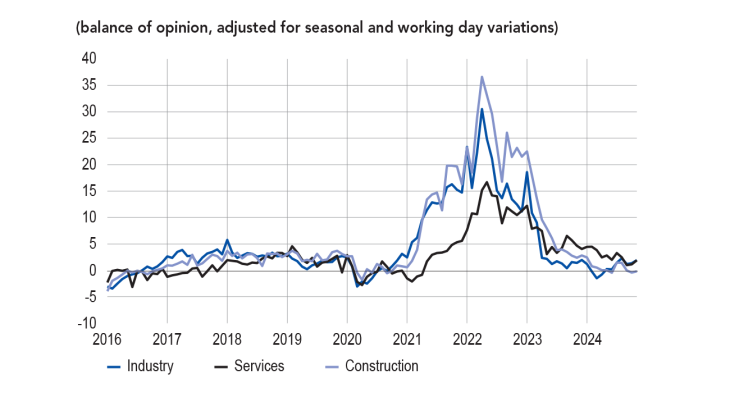
SHARE OF BUSINESSES REPORTING RECRUITMENT DIFFICULTIES
(%, unadjusted data)
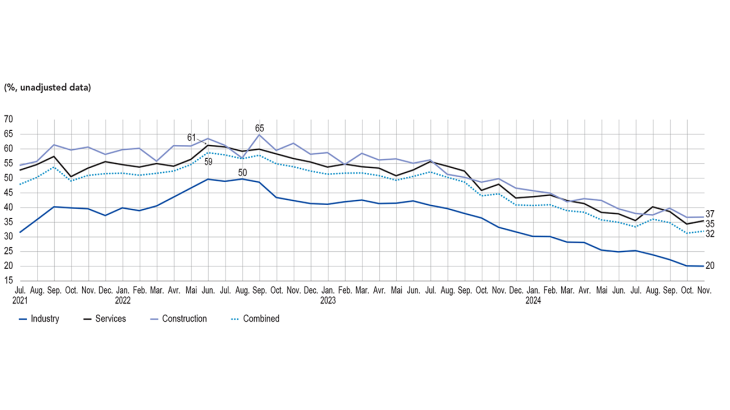
32% of business leaders reported recruitment difficulties in November, an increase of 1 percentage point on October, driven by market services (35%). This share was stable in industry (20%) and construction (37%).
4. Our estimates suggest that GDP will remain stable in the fourth quarter, with underlying growth continuing to rise at around 0.2% quarter‑on‑quarter, but offset by the impact of the Olympic Games
The detailed results of the quarterly accounts, published by INSEE at the end of November, confirmed the strong growth in GDP in the third quarter of 2024, up 0.4% on the previous quarter. Activity contracted in agriculture, was stable in the manufacturing industry and construction sector, and rose in energy, and market and non‑market services. The temporary effect of the Olympic and Paralympic Games on growth in the third quarter is estimated at around a quarter of a percentage point, driven mainly by household services (ticketing) and- information and communication (event broadcasting rights).2
Based on the results of the Banque de France monthly business survey (MBS), as well as other available data (INSEE industry production indices and surveys and high‑frequency data), and coupled with the impact of the Olympic Games (– 0,2 percentage point), we expect GDP to be stable in the fourth quarter.
Excluding the impact of the Olympic Games, value added in market services is set to grow this quarter, albeit at a more moderate pace than in the previous quarter. Value added in the energy sector is expected to fall, while it should rise slightly in manufacturing, as reflected in the quarterly average of the monthly business survey balances. Lastly, construction is expected to decline once again this quarter, still being ragged down by the sluggishness of new builds.
QUARTERLY CHANGES IN GDP AND VALUE ADDED IN FRANCE
(%)
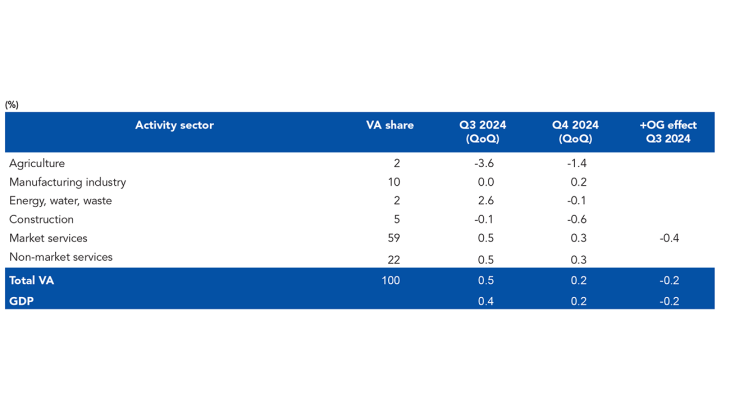
Note: QoQ = quarterly change.; OG, Ollympic Games.
1 The balance of opinion is the difference between the share of business leaders reporting increases or decreases, weighted by the intensity of the variation (with three possible grades in the monthly business survey: low, normal and high). A business leader indicating a “high” increase in prices will, all other things being equal, influence the balance of opinion more than a business leader indicating a “low” increase.
2 See Banque de France Bulletin, 3 December 2024. (Available soon in English)
Download the full publication
Updated on the 17th of December 2024